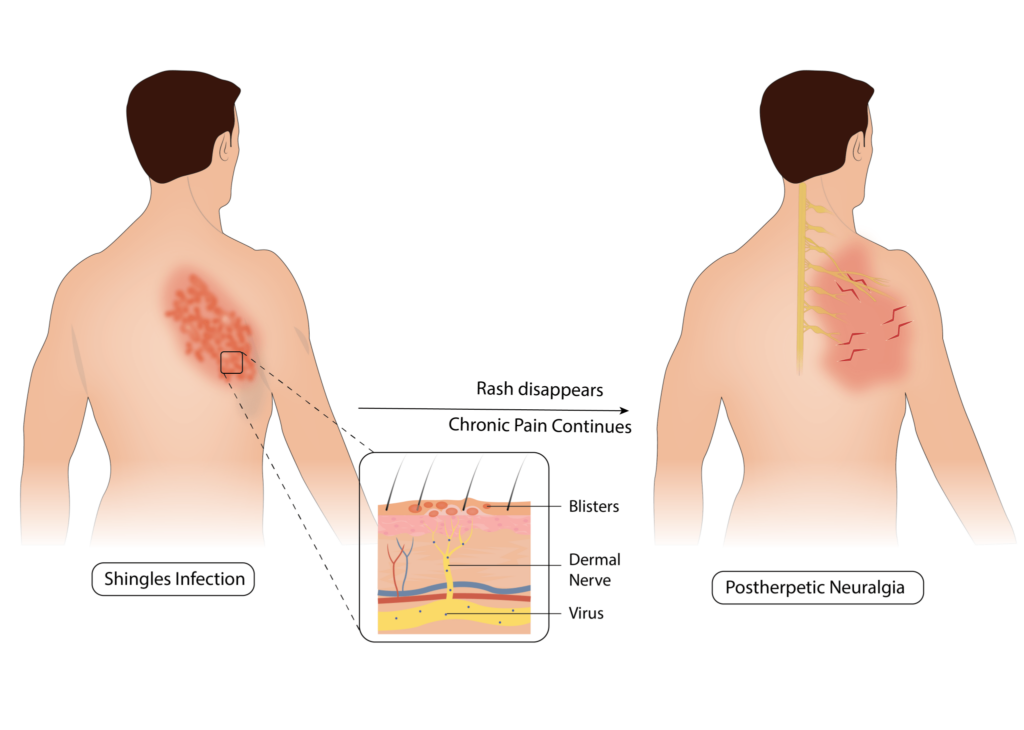Chronic Shingles: Post-Herpetic Neuralgia "PHN"
PHN is chronic pain following a Shingles infection.
In some people, the rash of shingles subsides, but the pain does not go away. This chronic pain is due to damage to the sensory nerves caused by the virus and the body’s inflammation reaction!
Chickenpox, shingles and PHN are all caused by the same virus infection. After getting chickenpox as a child, the virus stays in the body, living quietly in nerves attached to the spinal cord.
Shingles happens when the virus “awakens” from its hiding place in the nerves, usually in people more than 50 years old. It travels down the nerve and causes a burning red rash on the abdomen, chest, arms or face. The pain can be unbearable!

Patients affected by shingles and PHN are usually over 50 years of age, but anyone who has had chickenpox can get it. The shingles vaccine is available and is recommended for everyone over the age of 50, in order to prevent the infection.
PHN is usually diagnosed very easily. It almost always follows immediately after a shingles infection, which is typically a bright red, itchy, painful rash in one area on one side of the body (although not everyone has a rash with shingles). After the acute infection is over, and the rash has gone away, the pain persists in the same area.
The key is to recognize that the chronic pain is due to nerve injury from the virus infection and from the body’s reaction it. The damaged nerves send abnormal, constant pain signals to the brain.
This is a new revelation in the care of patients with PHN! Only a handful of doctors understand this phenomenon, and only a few have experience with the diagnosis and treatment.
Dr. Brown will examine you and correlate your pain which nerves are injured. Nerve blocks (small shots of local anesthetic) are then used to put the nerves to sleep temporarily to make the diagnosis. If the nerve blocks are successful in temporarily relieving the pain, then outpatient surgery is likely to help decrease/eliminate the pain permanently.
Doctors may prescribe medications, both oral and creams, to help with symptoms of the acute shingles infection. Some of these medications can also be helpful with the chronic pain of PHN, but rarely are they complete or long-lasting. If the pain can be proven to be due to nerve damage, surgery can be performed to disconnect the damaged portions of the nerves, so that the chronic pain signals cannot travel to the brain.
There are only a handful of surgeons performing these techniques. In the right hands, this straightforward outpatient operation is highly successful and provides a permanent solution!
Surgeons at Neuropax clinic successfully treat PHN – in many cases permanently – with resection of the small damaged nerves. With a straightforward examination and some local anesthetic injections in the clinic, the nerves injured during the acute infection can be found. This gives the surgeon a target on which to perform a neurectomy – a procedure that removes small portions of the nerves that are the cause of the pain – thereby disconnecting the pain signal from the brain. This leaves a numb patch on the skin where the pain used to be. The straightforward procedure is done as an outpatient – you go home the same day! In most cases, the nerve pain is gone or nearly gone the next day. In some patients the pain resolution can take a few months, as the cut nerve ends take time to heal.
Nerve Surgery Helps Relieve Chronic Pain
The majority of patients with chronic pain report significant decreases or complete resolution of their pain following nerve surgery. Most patients describe the ‘nerve pain feelings’ are improved as soon as the following day. Discomfort from the operation is frequently described as a completely different sensation, which subsides in the next few weeks.